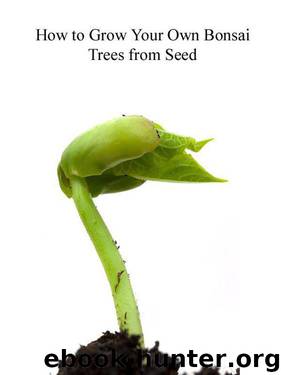How To Grow Your Own Bonsai Trees From Seed by Bruce Bullock

Author:Bruce Bullock [Bullock, Bruce]
Language: eng
Format: epub
Published: 2011-03-26T07:00:00+00:00
Sowing
When the time comes to sow your tree seed it is always best to have the seed tray or area prepared beforehand. Often it is advisable to very lightly spray the soil surface with water to lightly dampen the soil which can then ‘bind’ it for making the seed hole.
The next stage is to use your dibber (or whatever you use for this purpose) to make the holes for the seed. A rough approximation for the depth of the hole for the seed is about 2-3 times the length of the seed. An acorn for example would then be sown to a depth of approximately 2-2.5 inches (5-6cm), while a pine seed should be sown to an approximate depth of 8-10mm.
The dibber can be used to make the seed holes in the soil, spacing these in a straight line about 4cm apart and about 5cm between the rows. The spacing will also depend on the size of the seed.
The important principle here is that the emerging seedlings will have a small space between them so that they don’t compete too heavily for sunlight and nutrients. However this is not a hugely important issue and even if some of the seedlings are growing fairly closely together, they can easily be separated out at a later stage.
When sowing seeds that are very small in size and fine such as Rowan, Chinese Elm or Jacaranda, you can easily ‘sprinkle’ these on the surface of the seed tray, ensuring that they are spread out as evenly as possible, by releasing them through your fingers or gently tapping out the seed packet while moving it over the tray.
The surface is then lightly spread over with vermiculite or sieved compost so that it just covers the seed and does not cover it too heavily.
It can also be a good idea with this fine seed to leave one or two seeds just exposed so that you can observe when the seeds start to germinate.
Once the seeds have been placed in their holes, then these holes should be lightly covered over with soil by hand.
Finally the seed trays should be lightly watered with a fine spray so that the soil is just slightly moist. If it is too wet for too long then the seeds can rot.
When seeds are sown over autumn or winter to be left outdoors, or in a cool greenhouse, then they should not require much water during winter but the soil should still be monitored to ensure that it does not dry out.
If seeds are sown in spring or summer then the soil will need to be monitored much more carefully as they will require fairly regular watering.
Another easy way to sow seed in larger trays or in seed beds is to draw a line in the soil with a stick or the handle of a rake, to the depth required.
You can achieve a straight line by laying a twine down between two pegs, if the beds are large outdoor seed beds. The soil
Download
This site does not store any files on its server. We only index and link to content provided by other sites. Please contact the content providers to delete copyright contents if any and email us, we'll remove relevant links or contents immediately.
Turbulence by E. J. Noyes(7037)
The Thirst by Nesbo Jo(5785)
Gerald's Game by Stephen King(3918)
Be in a Treehouse by Pete Nelson(3211)
Marijuana Grower's Handbook by Ed Rosenthal(3118)
The Sprouting Book by Ann Wigmore(3052)
The Red Files by Lee Winter(2913)
The Remains of the Day by Kazuo Ishiguro(2617)
Sharp Objects: A Novel by Gillian Flynn(2445)
Christian (The Protectors Book 1) by L. Ann Marie(2394)
Organic Mushroom Farming and Mycoremediation by Tradd Cotter(2307)
The Culinary Herbal by Susan Belsinger(2060)
Stone Building by Kevin Gardner(1995)
The Starter Garden Handbook by Alice Mary Alvrez(1924)
Lilac Girls by Martha Hall Kelly(1870)
The Unlikely Pilgrimage of Harold Fry by Rachel Joyce(1836)
The Lean Farm Guide to Growing Vegetables: More In-Depth Lean Techniques for Efficient Organic Production by Ben Hartman(1784)
Urban Farming by Thomas Fox(1749)
Backyard Woodland by Josh VanBrakle(1587)
